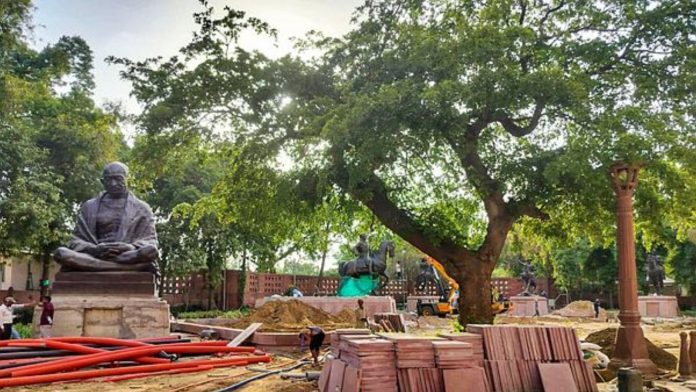Vivek Shukla
There is a commotion brewing over the relocation of the statues of Mahatma Gandhi, Baba Saheb Ambedkar, and Chhatrapati Shivaji Maharaj, which have stood in the Parliament House complex for decades. They are now being moved to new locations, to be called ” Prerna Sthal “. The question arises: what is the point of moving these statues of great figures of our nation from one place to another, especially after they have been in these spots for so many years? The entire country draws inspiration from them.
Their very presence exudes a unique blend of emotion and dynamism. For decades, visitors to Parliament House have bowed before them.
Let’s begin with the life-size statue of Mahatma Gandhi installed in Parliament House. The entire nation sees this statue on their television sets during every parliamentary session. Bapu is depicted in a meditative state. In front of him, leaders from different political parties hold protests or shout slogans to attract the government’s attention on various issues. This statue of Bapu was created by the renowned sculptor Ram Sutar. He is also the creator of the Statue of Unity, the monument dedicated to Sardar Patel. Ram Sutar is an expert at crafting captivating statues from concrete, clay, plaster of Paris, and other readily available materials. He is a man of conviction, never tiring. Unmindful of the weather, this unique artist is so engrossed in his art that he loses track of day and night. Atal Bihari Vajpayee was one of his ardent admirers. He has created hundreds of life-size and bust statues across India and abroad. But Ram Sutar considers the statue of Gandhi in Parliament to be one of his finest works. He always found it more pleasing to see larger-than-life statues of the nation’s heroes standing atop rocks or mountains, rather than confined within the walls of a building. As you stand near Gandhi’s statue in Parliament House, you truly feel elevated. A sense of peace washes over you. At times, it even feels like Gandhi is about to ask you a question. Clearly, many people are disappointed with the relocation of this statue from Parliament House.
Interestingly, the portrait of Gandhi was unveilved in Parliament house even in his life time on August 28, 1947. It was made by Oswald Birley (31 March 1880 – 6 May 1952). He was an English portrait painter. He painted several highly regarded portraits of Sir Winston Churchill and many war-time leaders such as Generals Eisenhower and Montgomery.
Bapu’s First Statue
Meanwhile, after the assassination of Mahatma Gandhi, the government entrusted 28-year-old sculptor Sadashiv Rao Sathe from Mumbai with the task of creating a life-size statue of the Father of the Nation. This statue was to be installed outside the Town Hall in Chandni Chowk in Delhi. Sathe was not known until then. However, he was beginning to make a name for himself as a promising young sculptor. He took on this momentous responsibility as a challenge and proved his creative genius by creating an unparalleled statue of Gandhi. This statue was unveiled in 1952. It is possibly the first life-size statue of Gandhi in the nation.
When was Baba Saheb’s Statue Installed?
The statue of Baba Saheb in the Parliament House complex was installed on April 2nd, 1967. The then-President of India, Dr. Sarvepalli Radhakrishnan, unveiled it. This statue was crafted by the great sculptor, B.V. Wagh. Meanwhile, the portrait of Baba Saheb in the Central Hall of Parliament House was painted by Zeba Amrohawi . This portrait was unveiled on April 12th, 1990, by Vishwanath Pratap Singh, who was the Prime Minister of India at the time. This statue is also being relocated to a new site. This is not right.
The first statue of Baba Saheb was installed at Ambedkar Bhavan, located on Rani Jhansi Road in capital city, on April 14th, 1957. Baba Saheb laid the foundation stone for Ambedkar Bhavan on April 16th, 1950. ” Dr. Saheb’s first birthday after his death on December 6th, 1956, saw the installation of his first statue here. After that, statues of Baba Saheb began to emerge all over the country, ” informs writer and poet Dr. Ravinder Kumar, whose father Heti Lal Pipal used to work with him ( Dr Ambedkar) when he was staying at 26 Shamnath Marg in capital.
The statue of Chhatrapati Shivaji Maharaj was installed in Parliament House on April 28th, 2003. It is a 18-foot tall statue made of copper. On the day it was unveiled, nearly all the parliamentarians from Maharashtra were present. It is also installed at a new place.
Meanwhile, Delhi showcased its deep respect for this valiant son of India by installing a life-size statue of Chhatrapati Shivaji Maharaj on the road leading from Connaught Place towards Minto Road in 1972. This statue was also sculpted by Sadashiv Rao Sathe. Who hasn’t been captivated by this equestrian statue? Chhatrapati Shivaji’s horse is standing on one leg. The statue will only stay balanced if the tail is secured with a strong rod for stability. Only an artist like Sadashiv Sathe could understand this.
In any case, those wise men who have decided to relocate the statues of Gandhi, Baba Saheb, and Chhatrapati Shivaji Maharaj from Parliament House should have given more thought before implementing their decision.
Trending Now
E-Paper


